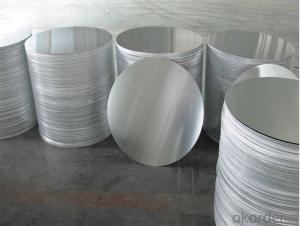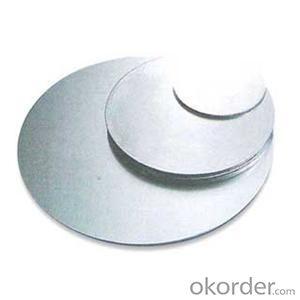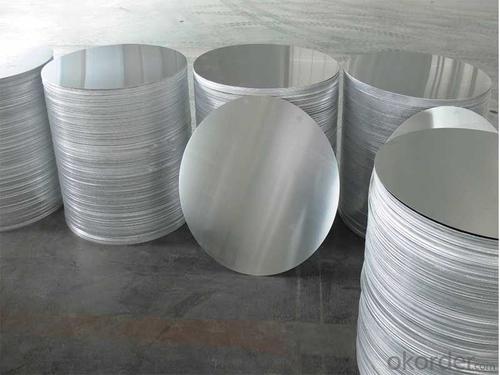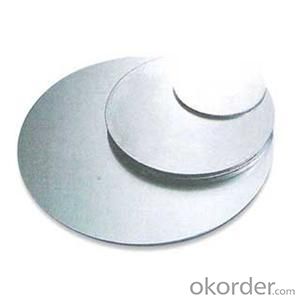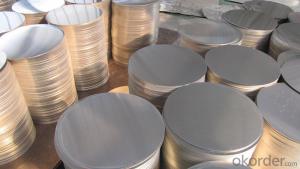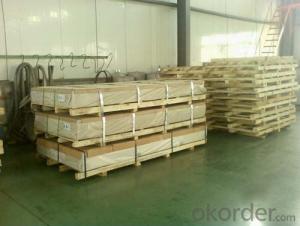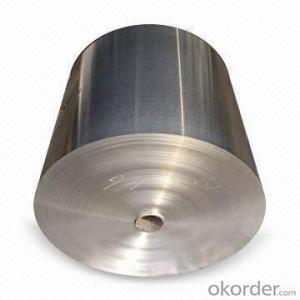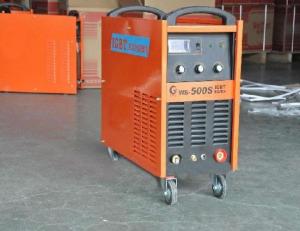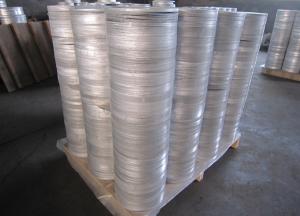Industrial Aluminum Circle for Spot Welding Aluminum Sheets
- Loading Port:
- China Main Port
- Payment Terms:
- TT OR LC
- Min Order Qty:
- -
- Supply Capability:
- -
OKorder Service Pledge
OKorder Financial Service
You Might Also Like
Aluminium alloys with a wide range of properties are used in engineering structures. Alloy systems are classified by a number system (ANSI) or by names indicating their main alloying constituents (DIN and ISO).
The strength and durability of aluminium alloys vary widely, not only as a result of the components of the specific alloy, but also as a result of heat treatments and manufacturing processes. A lack of knowledge of these aspects has from time to time led to improperly designed structures and gained aluminium a bad reputation.
One important structural limitation of aluminium alloys is their fatigue strength. Unlike steels, aluminium alloys have no well-defined fatigue limit, meaning that fatigue failure eventually occurs, under even very small cyclic loadings. This implies that engineers must assess these loads and design for a fixed life rather than an infinite life.
Another important property of aluminium alloys is their sensitivity to heat. Workshop procedures involving heating are complicated by the fact that aluminium, unlike steel, melts without first glowing red. Forming operations where a blow torch is used therefore require some expertise, since no visual signs reveal how close the material is to melting. Aluminium alloys, like all structural alloys, also are subject to internal stresses following heating operations such as welding and casting. The problem with aluminium alloys in this regard is their low melting point, which make them more susceptible to distortions from thermally induced stress relief. Controlled stress relief can be done during manufacturing by heat-treating the parts in an oven, followed by gradual cooling—in effect annealing the stresses.
The low melting point of aluminium alloys has not precluded their use in rocketry; even for use in constructing combustion chambers where gases can reach 3500 K. The Agena upper stage engine used a regeneratively cooled aluminium design for some parts of the nozzle, including the thermally critical throat region.
Another alloy of some value is aluminium bronze (Cu-Al alloy).
- Q: What are the different forming techniques for aluminum sheets?
- There are several different forming techniques that can be used to shape aluminum sheets. One common technique is called bending, which involves applying force to the sheet to bend it into a desired shape. This can be done manually using a press brake or through automated processes such as roll forming or stretch forming. Another technique is called deep drawing, which involves using a die and punch to stretch the aluminum sheet into a three-dimensional shape. This process is commonly used to create cylindrical or box-shaped components like cans or containers. Hydroforming is another forming technique that can be used for aluminum sheets. It involves using hydraulic pressure to shape the sheet against a mold or form. This technique is often used to create complex, irregular shapes that would be difficult to achieve with other methods. Spinning is a technique that is commonly used to create symmetrical shapes such as bowls or cones. It involves rotating the aluminum sheet against a mandrel while applying pressure to shape it into the desired form. Finally, there is also a technique called stamping, which involves pressing the aluminum sheet against a die to create a specific shape. This technique is often used for high-volume production of components such as automotive body panels. Overall, these forming techniques offer a range of options for shaping aluminum sheets into various forms and designs, allowing for flexibility and versatility in manufacturing processes.
- Q: Can aluminum sheets be used for balcony railings?
- Yes, aluminum sheets can be used for balcony railings. Aluminum is a popular material for balcony railings due to its lightweight nature, durability, and resistance to corrosion. It is a versatile material that can be easily formed into different shapes and designs, making it suitable for various architectural styles. Additionally, aluminum railings require minimal maintenance and can withstand harsh weather conditions, making them a practical and long-lasting choice for balcony railings.
- Q: Can aluminum sheets be used for reflective insulation?
- Yes, aluminum sheets can be used for reflective insulation. Aluminum is highly reflective and has good thermal conductivity, making it an excellent choice for reflecting heat and reducing heat transfer. When used as insulation, aluminum sheets can reflect heat away from the surface, preventing it from entering or escaping the desired area. This can help in maintaining a comfortable temperature inside a building or protecting sensitive equipment from extreme heat or cold. Additionally, aluminum sheets are lightweight and easy to install, making them a popular choice for reflective insulation applications.
- Q: Can aluminum sheets be used for pharmaceutical cleanrooms?
- Yes, aluminum sheets can be used for pharmaceutical cleanrooms. Aluminum is a popular choice for cleanroom construction due to its excellent durability, corrosion resistance, and ease of cleaning. It is also non-porous, which helps prevent the growth of bacteria and ensures a sterile environment. Additionally, aluminum sheets can be easily fabricated and installed, making them a suitable material for pharmaceutical cleanroom applications.
- Q: What are the different methods of surface cleaning for aluminum sheet?
- Different methods exist for cleaning aluminum sheets, each with unique advantages and suitability for various situations. Common methods include: 1. Mechanical Cleaning: Scrubbing the aluminum sheet with abrasive materials like sandpaper or wire brushes can physically eliminate dirt, oxidation, or other contaminants. Although effective for removing severe stains or corrosion, this method may cause scratches. 2. Chemical Cleaning: Utilizing cleaning agents or solvents, chemical cleaning dissolves and eliminates dirt, grease, or oxidation from the aluminum sheet. Depending on requirements, the cleaning agents can be acidic, alkaline, or neutral. This method is ideal for removing light stains or surface oxidation and is suitable for large-scale cleaning operations. 3. Electrolytic Cleaning: By immersing the aluminum sheet in an electrolyte solution and applying a direct current, electrolytic cleaning uses electricity to dissolve and separate contaminants from the surface. This method is effective for eliminating heavy oxidation, corrosion, or stubborn stains. 4. Ultrasonic Cleaning: Placing the aluminum sheet in a tank filled with a cleaning solution and subjecting it to high-frequency sound waves, ultrasonic cleaning creates tiny bubbles that dislodge dirt particles upon contact with the sheet's surface. It is suitable for removing fine particles, oils, or grease. 5. Steam Cleaning: High-pressure steam is employed in steam cleaning to remove dirt, grime, or contaminants from the aluminum sheet's surface. The steam's high temperature and pressure break down dirt particles and sanitize the sheet. This method effectively removes oils, greases, or organic residues. When selecting a cleaning method for aluminum sheets, factors such as the type and severity of contamination, desired cleanliness level, and specific application requirements must be considered. Additionally, it is crucial to follow safety guidelines and use appropriate protective equipment when handling cleaning agents or working with electrical equipment.
- Q: Can aluminum sheets be used for roofing applications?
- Aluminum sheets are suitable for roofing due to their lightweight and durable nature, along with their excellent resistance to corrosion. They are particularly well-suited for areas with high humidity or coastal regions that experience saltwater exposure. Known for their longevity and low maintenance requirements, aluminum roofing sheets are also fire-resistant and can withstand extreme weather conditions. This makes them a popular choice for residential and commercial roofing projects. Furthermore, aluminum sheets are easy to install and can be shaped and formed to fit various roof designs. In addition to their practical benefits, aluminum is an environmentally friendly option for roofing applications as it can be recycled repeatedly without any loss in quality.
- Q: Are aluminum sheets recyclable?
- Yes, aluminum sheets are recyclable.
- Q: How do aluminum sheets handle extreme temperatures?
- Aluminum sheets have excellent thermal conductivity, allowing them to efficiently distribute and dissipate heat. They can withstand extreme temperatures without warping, melting, or becoming brittle, making them highly reliable in both high and low-temperature environments.
- Q: Can aluminum sheets be used for lithographic printing?
- Yes, aluminum sheets can be used for lithographic printing. Lithographic printing, also known as offset printing, relies on the principle that oil and water do not mix. Aluminum plates are used as the printing surface in lithography because they can retain an image when treated with a combination of chemicals. The image areas attract ink, while the non-image areas repel it. This allows for high-quality and precise printing.
- Q: What specific tools or equipment are necessary for working with aluminum sheets?
- <p>Working with aluminum sheets typically requires a few specialized tools and equipment. These include a metal cutting saw for precise cuts, a metal file or sandpaper for smoothing edges, a metal shear for cutting, and a drill with metal bits for making holes. A roller or bending brake is useful for shaping the sheets, and a T-square or straight edge is important for marking straight lines. Safety equipment such as gloves, goggles, and a dust mask are also essential to protect against sharp edges and metal dust.</p>
Send your message to us
Industrial Aluminum Circle for Spot Welding Aluminum Sheets
- Loading Port:
- China Main Port
- Payment Terms:
- TT OR LC
- Min Order Qty:
- -
- Supply Capability:
- -
OKorder Service Pledge
OKorder Financial Service
Similar products
Hot products
Hot Searches
Related keywords
